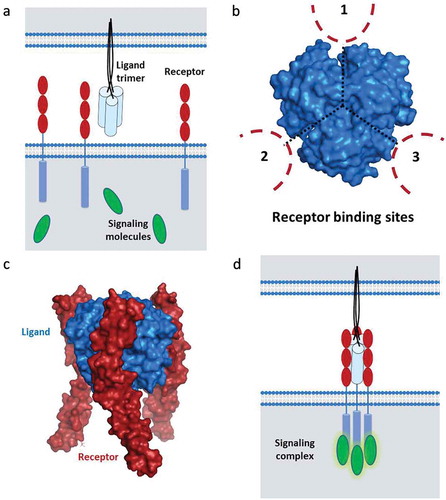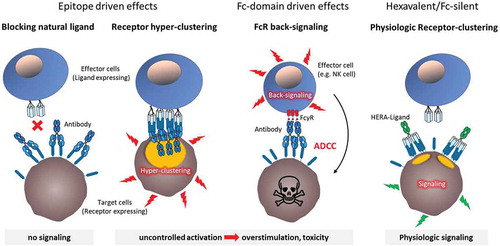Figures & data
Figure 1. Requirements for TNF-R-SF signaling.
TNF-R-SF signaling is a structurally well-defined event that requires proper three-dimensional receptor clustering and trimerization. A. The TNF-SF ligands naturally exist as trivalent functional units and the receptors are usually separated on the cell surface. B. The assembled TNF-SF ligands contain three receptor-binding sites that are located at the three identical clefts between the neighboring monomers. C. Receptor assembly into functional trimeric signaling complexes occurs through binding of the natural ligand unit. D. The interaction of these trimeric TNF-SF ligands with their corresponding receptors, expressed on the surface of other cells, leads to very precise receptor clustering followed by intracellular signal transduction.

Table 1. Antibody-based CD40-targeting compounds in ongoing clinical trials.
Table 2. Gene therapy and recombinant CD40 agonists in ongoing clinical trials.
Figure 2. Side effects of CD40 agonistic antibodies versus fusion molecules.
The orientation of the target epitope of CD40 agonistic antibodies within the CD40 molecule defines epitope-driven effects. In case the antibody prevents binding of the natural CD40L it inevitably inhibits favorable natural CD40 signaling. Contrarily, cross-linking receptor complexes that have been trimerized by the natural ligand can lead to hyper-clustering and uncontrolled overstimulation with increased risk of toxic side effects and exhaustion of immune cells. Fc-domain driven effects derive from the interaction of the antibody´s Fc domain with Fc receptors on different immune cells leading to unwanted (back-)signaling. Upon Fc receptor engagement these immune cells exert diverse effector functions such as ADCC thereby not only depleting the target cell population but also contributing to unspecific immune system activation. In contrast, agonistic fusion proteins with a hexavalent/Fc-silent structure preclude the aforementioned characteristics, possibly generating a more physiologic activity.

